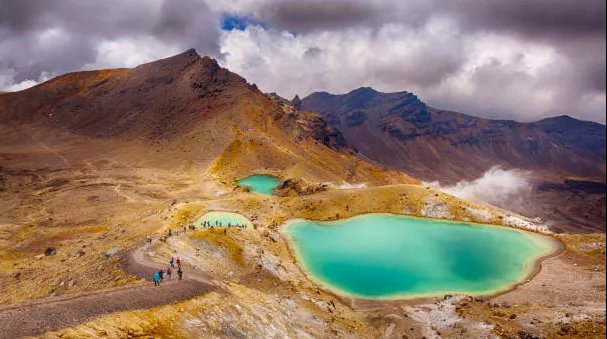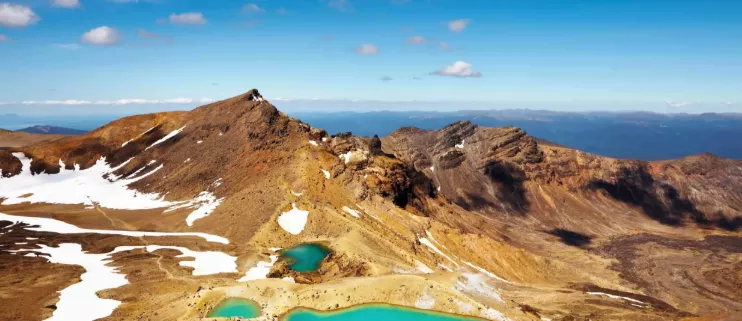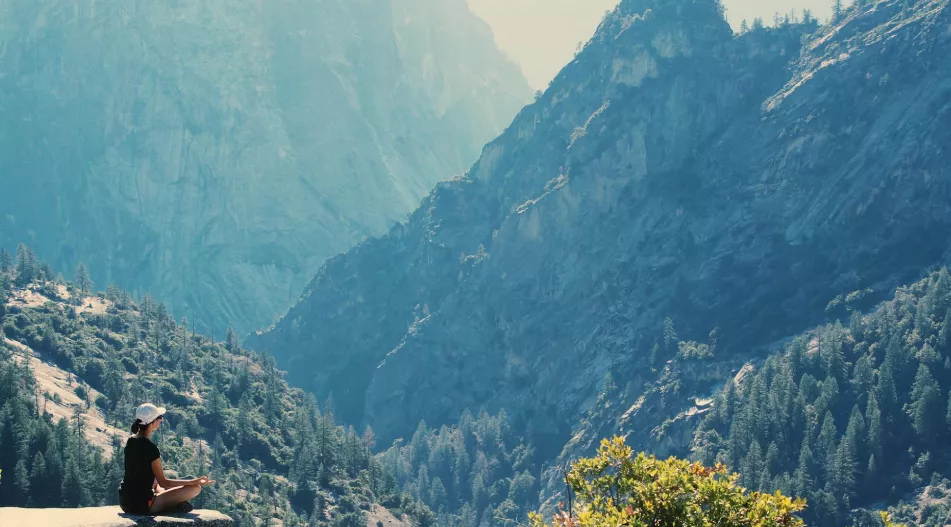Among New Zealand’s many treasures, Tongariro National Park stands out for its stunning scenery as well as its rich history and cultural significance. Established in 1887, it is the country’s first national park and holds a special place in both the natural landscape and the history of the Māori people. With its breathtaking volcanic mountains, diverse ecosystems, and wealth of outdoor activities, Tongariro National Park is a must-see for nature lovers and adventurers alike.
Everything You Need to Know
- Tongariro, New Zealand’s first national park, was established in 1887.
- The Māori—especially the Ngāti Tūwharetoa tribe—hold the park in high cultural regard.
- Visitors can explore geothermal features, lakes, and dramatic volcanic peaks.
1. The Rich History of Tongariro National Park
There is more to Tongariro National Park than meets the eye—it is a place steeped in history. This area has been significant for centuries, where the forces of nature and the depth of culture converge. Tongariro’s long and storied past begins with its spiritual significance to the Māori people, continues with its designation as New Zealand’s first national park, and culminates in its recognition as a UNESCO World Heritage Site.
Cultural Significance to the Māori
The mountains of Tongariro National Park are more than just natural features—they are sacred ancestral lands to the Māori people. The most revered of these peaks are Tongariro, Ngauruhoe, and Ruapehu. They symbolize a deep connection between the natural and spiritual worlds. Over generations, the area has been the setting for countless legends, ceremonies, and customs. The mountains are considered taonga (treasures), and their preservation is essential to Māori cultural identity. Visitors to the park should remain aware of its spiritual significance and show respect accordingly.
Establishment as New Zealand’s First National Park
In 1887, something truly remarkable happened. Māori chief Te Heuheu Tukino IV gifted the sacred peaks of Tongariro to the people of New Zealand. This generous and visionary act led to the creation of Tongariro National Park—the first national park in the country. It was a groundbreaking move that protected the land and acknowledged the rights of the Māori and their deep connection to it.
This gesture set a powerful precedent for future conservation efforts and for recognizing Indigenous ties to the land. It’s a story of foresight, respect, and collaboration—one that helped shape New Zealand’s approach to environmental protection. Today, the presence of the Rātana Temple in the region further reflects the area’s rich cultural and spiritual heritage.
UNESCO World Heritage Status
Tongariro National Park’s significance extends far beyond New Zealand. It has earned UNESCO World Heritage status—not just for its breathtaking natural features, but also for its profound cultural value. It’s one of the few places in the world recognized under both natural and cultural criteria.
This dual recognition honors the park’s unique combination of dramatic volcanic landscapes and its deep spiritual significance to the Māori people. Being a World Heritage Site connects Tongariro to a global network of protected areas, ensuring its preservation for future generations.
The park’s UNESCO status highlights the need to protect both the environment and the cultural narratives that live within it. It’s a reminder that some places are extraordinary not only because of how they look but because of the stories they carry.
2. Exploring the Natural Wonders
The dramatic natural beauty of Tongariro National Park rivals its rich history. From towering volcanoes to rare ecosystems, the park offers a breathtaking variety of landscapes that captivate every visitor. Its diverse terrain invites exploration and encourages a deeper connection with the natural world.
Volcanic Peaks and Landscapes
With Mount Ruapehu, Mount Ngauruhoe, and Mount Tongariro dominating the skyline, it’s clear that volcanic activity is at the heart of the park. For centuries, these volcanoes have shaped the land, carving out a dynamic and awe-inspiring environment. Imagine walking through valleys etched by ancient lava flows or standing in awe as snow-capped peaks contrast against a clear blue sky. These powerful geological features are constant reminders of Earth’s raw energy—and the park’s volcanic core is truly a sight to behold.
Unique Flora and Fauna
Despite the harsh conditions, Tongariro National Park supports a surprising array of plant and animal life. Resilient alpine flora, hardy shrubs, and bursts of colorful wildflowers cling to rocky slopes. Keen observers may spot native birds like the playful fantail or the inquisitive North Island robin flitting among the trees. The remarkable adaptability of these species is a testament to nature’s resilience and creativity.
Ecosystems to Discover:
- Red tussock grasslands
- Sub-alpine shrublands
- Native beech forests
Stunning Lakes and Geothermal Features
Beyond its volcanic peaks, the park also boasts striking lakes and fascinating geothermal areas. The Emerald Lakes, glowing with vivid hues from dissolved minerals, are a favorite among hikers. Nearby, bubbling mud pools and steaming vents reveal the fiery forces still at work beneath the surface.
These geothermal features add another layer of intrigue to the park’s already diverse landscape. The contrast between the serene, reflective lakes and the seething geothermal zones creates a truly unforgettable experience. It’s a powerful reminder that beauty and life can thrive in even the most seemingly inhospitable environments.
3. Adventure Activities in Tongariro National Park
Tongariro National Park doesn’t just offer breathtaking scenery—it’s also a playground for adventure lovers. Whether you prefer hiking, skiing, or mountain biking, Tongariro National Park offers a variety of activities that will excite your heart. I remember being blown away by the sheer variety of options the first time I visited. As New Zealand’s first national park, it’s the perfect place to stay, play, and explore.
Hiking the Tongariro Alpine Crossing
The Tongariro Alpine Crossing truly shines. It’s no exaggeration to call this one of the best day hikes in the world. The scenery is unreal: steaming vents, colorful crater lakes, and volcanic peaks that look like they belong on another planet. The 19.4-kilometer trek is a challenge, so you’ll want to be in decent shape—but trust me, every step is worth it.
Weather in the park can change in an instant, so it’s essential to check the forecast before setting out. I’ve heard far too many tales of individuals becoming stranded in adverse weather conditions.
Quick Tips:
- Start early to avoid the crowds
- Wear sturdy hiking boots
- Bring plenty of water and snacks
Skiing and Snowboarding
When winter rolls around, Tongariro transforms into a snowy wonderland. Whether you’re a pro or a beginner, the slopes at Whakapapa and Turoa ski fields have something for everyone. I’m no expert, but skiing here is an absolute blast. Are you not a skier? No problem—sledding, snowball fights, and building snowmen are just as fun. It’s the perfect winter day out for the whole family.
Mountain Biking Trails
If you prefer two wheels to two feet, Tongariro also delivers on mountain biking. With trails ranging from gentle scenic rides to adrenaline-pumping downhill courses, there’s something for every skill level. One standout is the Old Coach Road, which winds through native bush and crosses historic viaducts—it’s an adventure with a side of history. Cultural tours led by local Māori guides are also available, offering a deeper connection to the land as you ride.
Friendly Reminder: Stick to designated trails, take your rubbish with you, and leave only footprints. Let’s help keep Tongariro’s wild beauty intact for generations to come.
Wrapping Up Your Tongariro Adventure
In the end, Tongariro National Park is a must-visit for adventurers and nature lovers alike. From awe-inspiring landscapes to a deep connection with Māori culture, this park truly has something for everyone. Whether you’re hiking the world-renowned Tongariro Alpine Crossing or simply soaking in the views, your time here is bound to be unforgettable.
So grab your gear (don’t forget your camera!), and get ready for an epic journey through one of New Zealand’s most iconic regions. Trust me—you’re going to love it.
Frequently Asked Questions
- What is Tongariro National Park known for?
Tongariro National Park is renowned for its stunning volcanic landscapes, rich Māori heritage, and a wide range of outdoor adventures, including hiking, skiing, and mountain biking.
- How was Tongariro National Park established?
The park was established in 1887, thanks to a generous land gift from the respected Māori chief Te Heuheu Tukino IV, who sought to protect the sacred peaks for future generations. It became New Zealand’s first national park.
- What are some popular activities in Tongariro National Park?
Visitors can enjoy hiking the Tongariro Alpine Crossing, skiing or snowboarding on Mount Ruapehu, and cycling scenic trails like the Old Coach Road.
Everything you need—flights, hotels, car rentals, bike rentals, taxis, and eSIMs for travelers—book it all with Voyage Magnets.






